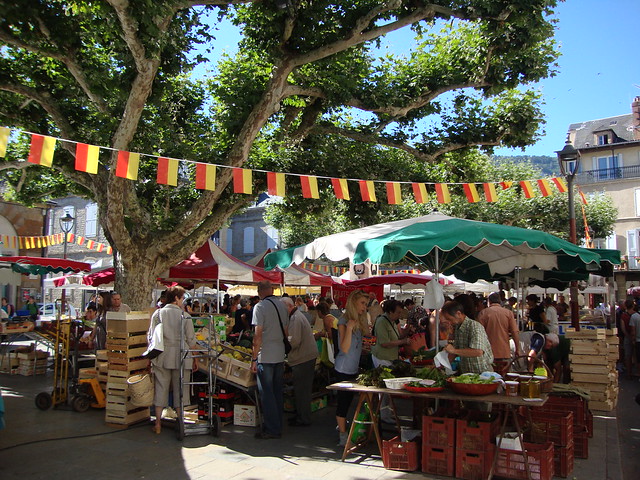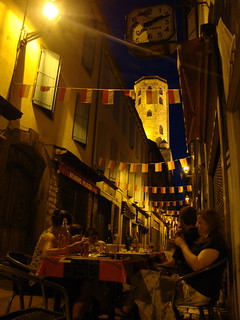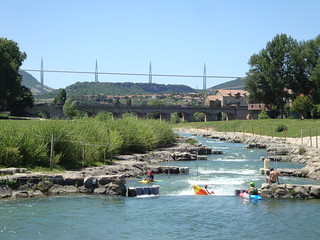I blogged in my previous post about the Millau viaduct, and whether I thought it was worthy of “world wonder” status. My conclusion was less enthusiastic than most of my fellow travel companions. However, I think the real strength of the bridge lies not in its specific merits as a bridge but in the effect it had on the town of Millau (understandably enough – bridges aren’t there just to be pretty, they’re there to do a job).
Millau viaduct was built to bridge a deep valley and connect two major parts of the region, and I understand that prior to the bridge’s construction Millau was a horribly congested town because the only way across the valley was through its centre.
Wandering the quiet, pretty and tightly-packed centre of the town, two thoughts occur. One, how miserably noisy and polluted the place must have been when treated effectively as a major thoroughfare for busy traffic. And two, how fresh, light and pleasant Millau seems now. It’s almost like in the fresh air, bright buildings and vibrant streets you could sense that the town was still enjoying the novelty of its new found freedom, that it was just waking up and rediscovering itself. Free from being a surrogate highway, it was like the town and its tourist industry could now fully breathe at last. No longer was it a place to drive through in frustratingly slow traffic – it was freed up to be a destination in itself.
The atmosphere was no doubt significantly enhanced by the presence of a jazz festival during the two days we were there, plus the bustle of the height of the tourist season, giving Millau an enjoyable vibrancy. Somehow, though, the town seemed to exude a magical balance – it was alive, busy and had lots going on; but avoided being too brash, crowded and oppressive in its tourist popularity.
Not of course that the bridge had simply freed Millau from the traffic before clearing off into the sunset to leave the town bypassed and forgotten.
The bridge still loomed large, literally and figuratively, over the town. From certain vantage points, the bridge presented an attractive and iconic backdrop, and far from now being bypassed by traffic, the town received a whole new boost because it was now on the map. The bridge was worth coming to, so the town attracted more tourists than it did before. There must have been an economic boom from the long period of construction work. The bridge itself has a busy visitor centre, creating a modest number of jobs. Plus we heard that because of its world-famous icon, the town was now a major conference venue for the south of France. Millau had been reborn, and this showed in its confident and attractive atmosphere.
As such, we really enjoyed our two days in Millau, and I could have happily lingered longer. There were plenty bars and cafes to hang out in, a lovely river to walk along, and judging by the numerous paragliders in the sky and canoeists on the river, a thriving outdoor activities industry.
The town felt welcoming, pretty, well-resourced for the visitor, and had an aura of a justifiable self-importance with the towering influence of the viaduct.
While I was less than fully won over by the merits of the viaduct itself, its true brilliance lies on the effect it has had on Millau. A town that really felt like it had found itself again – and been found by many an impressed visitor.





